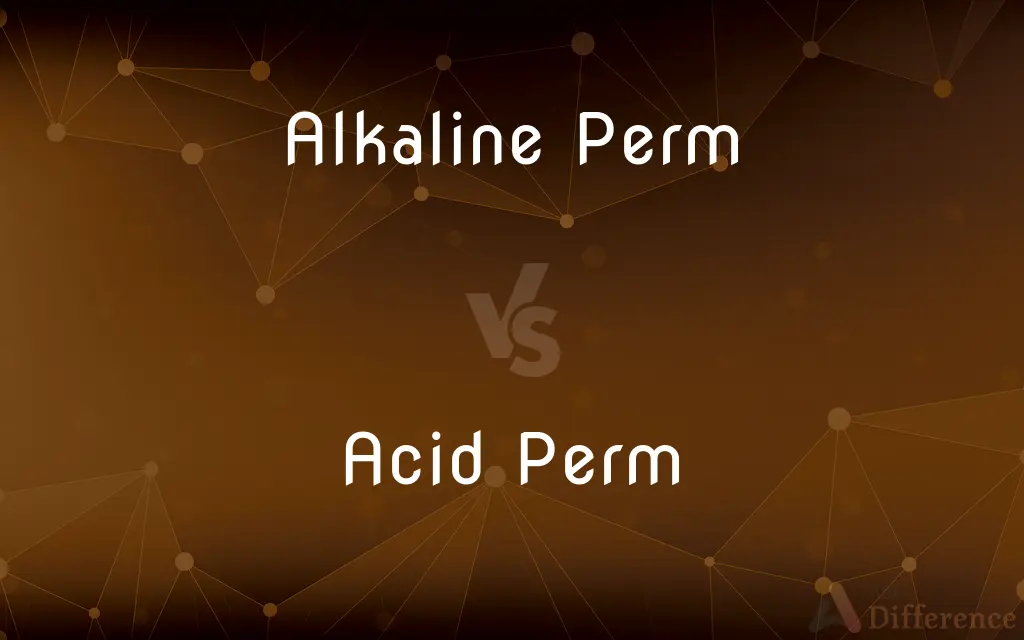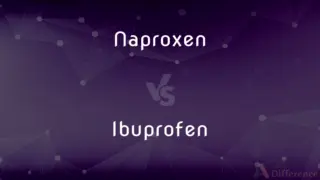Alkaline Perm vs. Acid Perm — What's the Difference?
Edited by Tayyaba Rehman — By Urooj Arif — Published on March 6, 2024
Alkaline perm creates strong, tight curls with a high pH, while acid perm offers gentler, softer curls at a lower pH, making it suitable for delicate hair.

Difference Between Alkaline Perm and Acid Perm
Table of Contents
ADVERTISEMENT
Key Differences
Alkaline perms, with their higher pH, break down hair bonds more aggressively, resulting in resilient curls. This makes them ideal for coarse or resistant hair that doesn't easily curl. In contrast, acid perms have a lower pH closer to that of natural hair, causing less cuticle swelling and offering a milder processing alternative. This gentleness makes acid perms preferable for fine or damaged hair, reducing the risk of further harm.
Alkaline perms generally work faster due to their strong chemical composition, which can efficiently reshape the hair structure into tight curls. This efficiency is beneficial for those seeking dramatic curling results. On the other hand, acid perms work slower, necessitating heat to boost the curling process. This slower process and the need for heat make acid perms a time-consuming yet hair-friendly option.
The end result of an alkaline perm is usually very defined and lasting curls, making it a popular choice for individuals desiring a permanent change. However, the strength of the chemicals used can leave hair feeling dry or brittle if not properly cared for post-treatment. Acid perms yield more natural-looking waves or curls with added shine, as the gentler processing helps preserve hair's natural moisture and integrity.
Choosing between an alkaline or acid perm often comes down to hair type and condition. Those with healthy, thick, or difficult-to-curl hair might opt for an alkaline perm, while individuals with colored, fine, or damaged hair might find acid perms to be a safer, more hair-friendly option.
Despite the differences, both perm types require professional application and proper aftercare, including the use of suitable shampoos, conditioners, and treatments designed for chemically treated hair to maintain the health and longevity of the curls.
ADVERTISEMENT
Comparison Chart
PH Level
High (above 7)
Lower (closer to natural hair pH)
Suitable Hair Type
Coarse, resistant
Fine, lightly damaged, or colored
Curl Type
Tight, well-defined curls
Softer, more natural-looking curls
Processing Time
Faster
Slower, often requires heat
Hair Damage Potential
Higher, due to stronger chemicals
Lower, due to gentler processing
Compare with Definitions
Alkaline Perm
Can lead to dryness or brittleness if not cared for properly.
After her alkaline perm, she followed a strict hair care regimen to avoid dryness.
Acid Perm
Preserves hair's moisture and integrity.
Thanks to the acid perm, her curls felt soft and healthy, not dry.
Alkaline Perm
Offers dramatic transformation for those seeking permanent curls.
The alkaline perm provided her with a dramatic change, from straight to curls.
Acid Perm
Ideal for colored or damaged hair, minimizing further harm.
To avoid damaging her bleached hair, she chose an acid perm.
Alkaline Perm
Works quickly due to its strong chemicals.
The stylist mentioned the alkaline perm would take less time to set than expected.
Acid Perm
Produces softer, more natural-looking curls.
The acid perm gave her soft waves that looked naturally hers.
Alkaline Perm
A chemical treatment that uses a high pH solution to create tight curls.
She opted for an alkaline perm to transform her straight, thick hair into bouncy curls.
Acid Perm
Requires heat and takes longer to process.
The acid perm took longer, but the added heat helped set the gentle curls.
Alkaline Perm
Designed for resistant hair types, offering long-lasting curls.
His coarse hair took well to the alkaline perm, giving him the curly look he wanted.
Acid Perm
Uses a milder, lower pH solution for gentler curling.
Her fine hair was perfect for the gentle process of an acid perm.
Common Curiosities
Who should get an alkaline perm?
Individuals with coarse, thick, or resistant hair that is difficult to curl may benefit from an alkaline perm.
Who should get an acid perm?
Those with fine, colored, or previously damaged hair might opt for an acid perm to minimize further hair damage.
What is an alkaline perm?
An alkaline perm is a chemical hair treatment that creates tight, long-lasting curls by using a high pH solution.
What is an acid perm?
An acid perm is a gentler chemical hair treatment that forms softer, more natural-looking curls, suitable for delicate hair.
How long does an alkaline perm last?
An alkaline perm can last several months, depending on hair type and maintenance.
Can I color my hair after getting a perm?
It's advisable to wait several weeks before coloring permed hair to avoid excessive damage.
What kind of curls does an acid perm produce?
Acid perms produce softer, more natural-looking waves or curls.
How does hair type affect perm choice?
Hair type and condition (e.g., coarse vs. fine, healthy vs. damaged) significantly influence whether an alkaline or acid perm is more appropriate.
Can perms cause hair damage?
Yes, both types of perms can cause hair damage, but proper aftercare can minimize this risk.
How can I care for my perm?
Use shampoos, conditioners, and treatments formulated for chemically treated hair, and avoid excessive heat styling.
Is an acid perm less damaging than an alkaline perm?
Yes, acid perms are generally less damaging due to their lower pH and gentler curling process.
What kind of curls does an alkaline perm create?
Alkaline perms create tight, well-defined curls.
Are perms permanent?
Perms are not permanent but can last several months with proper care, gradually relaxing over time.
Do perms work on all hair types?
Perms can be adjusted to work on most hair types, but the effectiveness and final look can vary.
What is the main difference between alkaline and acid perms?
The main difference lies in their pH level and the resulting strength of the curling process, affecting suitability for different hair types.
Share Your Discovery

Previous Comparison
Naproxen vs. Ibuprofen
Next Comparison
Gophers vs. Ground SquirrelsAuthor Spotlight
Written by
Urooj ArifUrooj is a skilled content writer at Ask Difference, known for her exceptional ability to simplify complex topics into engaging and informative content. With a passion for research and a flair for clear, concise writing, she consistently delivers articles that resonate with our diverse audience.
Edited by
Tayyaba RehmanTayyaba Rehman is a distinguished writer, currently serving as a primary contributor to askdifference.com. As a researcher in semantics and etymology, Tayyaba's passion for the complexity of languages and their distinctions has found a perfect home on the platform. Tayyaba delves into the intricacies of language, distinguishing between commonly confused words and phrases, thereby providing clarity for readers worldwide.
















































